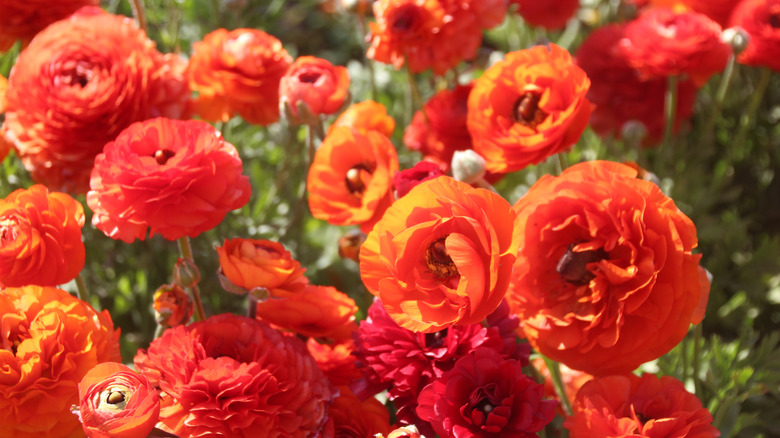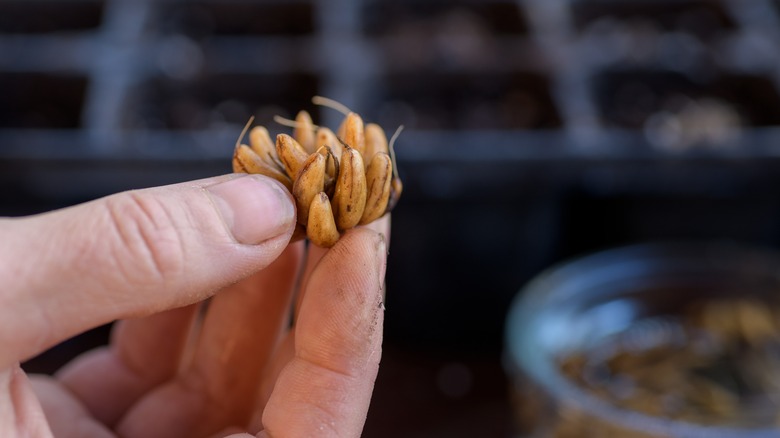Add This Beautiful Plant To Your Garden This Spring For Vibrant Color
Are you looking to plant a showstopper of a flower this spring? As winter approaches its end, anticipation for new life begins to build. Your garden may look dreary and in need of a burst of color. The cold weather can make it seem like it is too early to do any planting, but spring can actually be the perfect time to get some gorgeous flowers into the ground. There are several blooms to choose from, but Persian buttercups (Ranunculus asiaticus) are one of the best flowers for your garden. This beautiful plant has brilliant-colored petals that will provide a vibrant jumpstart to your backyard. Not only do they come in deep reds, fiery yellows, oranges, and pale pinks, but they also are long-lasting in bouquets and vases and look crisp and classy in pots or garden borders.
Persian buttercups are hardy in USDA zones 8 through 11. These blooms can be planted in the spring in colder weather climates, or they can be planted in the fall in warmer weather. Ranunculus make great companion plants for calendulas, sweet peas, snapdragons, and pansys, so pair them with these beautiful friends for lots of colorful flowers in your spring border garden.
The advantage of the Persian buttercup's corm
If you are looking to have a flower that you can plant and basically just wait for the burst of flowering color, these 1 to 2 foot high charming blooms are a great choice. Underneath the soil, the flower's rosey and paper-mache petals are supported by a tough and sturdy corm. However, don't let the corm feature of the Persian buttercup fool you into thinking it is extremely complicated to plant or maintain, as the corm actually provides some important benefits.
While similar to a bulb, a corm differs in that it is one solid organ that looks like it has fingers, while a bulb is round and layered like an onion. One of the beautiful aspects of a bulb or corm is that it can store and supply its own nutrients for future growing seasons. Instead of having to spend extra money boosting the flower up with lots of fertilizer in the spring, it withdraws from its own savings account. Additionally, corms sometimes produce cormels which can be divided and then spaced out in your garden to increase flower coverage. Before planting, soak your corms in water to hydrate them. In warmer areas, Persian buttercups are planted in the fall where they can save growing energy for the spring. If you live in a colder climate, it is best to plant them in early spring, which will result in mid-summer blossoms.
Planting and caring for Persian buttercups
Persian buttercups love the sun, so make sure to plant them in an area where they will get at least six hours of light. In early spring, dig a 2 to 3-inch deep hole and place your corms with the fingers face down. These flowers also prefer well-draining soil. If you have clay soil, you can either add compost to increase drainage or you can plant in pots or containers. In about 90 days after planting, sit back and enjoy the show; these beauties will flower and continue blooming for about three months.
Ranunculus only need to be watered when the soil has completely dried, and the morning is usually the best time of day to water your plants. In warmer climates, a layer of mulch will keep them cool and prevent them from going dormant. Dormancy occurs when temperatures reach about 90 degrees Fahrenheit. For areas colder than zone 8, dig up the corms in the fall and store them indoors until replanting in the spring. Corms in zone 8 or above can be divided and replanted in the fall and only need water every couple days until new shoots appear.
Being part of the buttercup family, Persian buttercups are slightly poisonous to people and pets, causing minor skin irritation or sickness if ingested. However, do not let that keep you from planting these gorgeous flowers. Just ensure you wear gloves and protect your family members.


